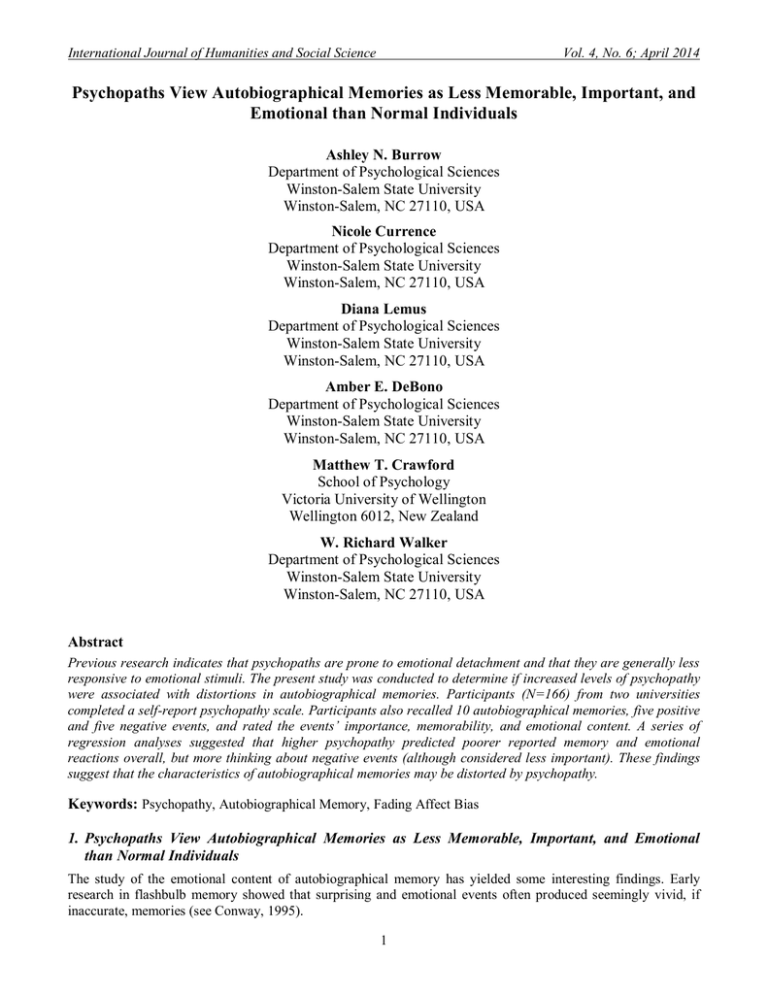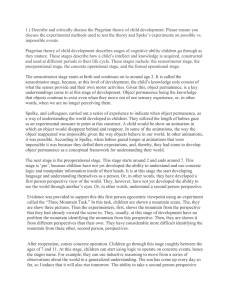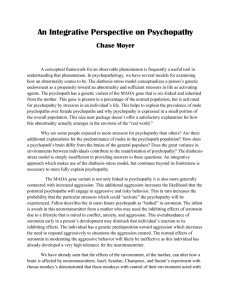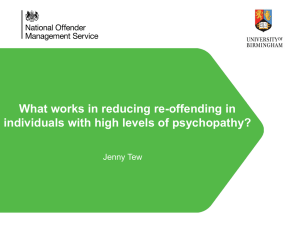Document 10465631
advertisement

International Journal of Humanities and Social Science Vol. 4, No. 6; April 2014 Psychopaths View Autobiographical Memories as Less Memorable, Important, and Emotional than Normal Individuals Ashley N. Burrow Department of Psychological Sciences Winston-Salem State University Winston-Salem, NC 27110, USA Nicole Currence Department of Psychological Sciences Winston-Salem State University Winston-Salem, NC 27110, USA Diana Lemus Department of Psychological Sciences Winston-Salem State University Winston-Salem, NC 27110, USA Amber E. DeBono Department of Psychological Sciences Winston-Salem State University Winston-Salem, NC 27110, USA Matthew T. Crawford School of Psychology Victoria University of Wellington Wellington 6012, New Zealand W. Richard Walker Department of Psychological Sciences Winston-Salem State University Winston-Salem, NC 27110, USA Abstract Previous research indicates that psychopaths are prone to emotional detachment and that they are generally less responsive to emotional stimuli. The present study was conducted to determine if increased levels of psychopathy were associated with distortions in autobiographical memories. Participants (N=166) from two universities completed a self-report psychopathy scale. Participants also recalled 10 autobiographical memories, five positive and five negative events, and rated the events’ importance, memorability, and emotional content. A series of regression analyses suggested that higher psychopathy predicted poorer reported memory and emotional reactions overall, but more thinking about negative events (although considered less important). These findings suggest that the characteristics of autobiographical memories may be distorted by psychopathy. Keywords: Psychopathy, Autobiographical Memory, Fading Affect Bias 1. Psychopaths View Autobiographical Memories as Less Memorable, Important, and Emotional than Normal Individuals The study of the emotional content of autobiographical memory has yielded some interesting findings. Early research in flashbulb memory showed that surprising and emotional events often produced seemingly vivid, if inaccurate, memories (see Conway, 1995). 1 © Center for Promoting Ideas, USA www.ijhssnet.com The emotional content of event memories is often subject to the processes of emotion regulation. According to the Fading Affect Bias (FAB), negative affect associated with autobiographical events fades more quickly than the positive affect associated with autobiographical events. The FAB was documented using a number of procedures (e.g., Landau & Gunter, 2009; for reviews see Skowronski, Walker, Henderson, & Bond, 2013; Walker & Skowronski, 2009), including both retrospective and prospective methods, and has also been documented in a number of cultures (Ritchie, Batteson, et. al, 2014). The FAB is thought to be the result of a set of emotion regulation processes that serve to create a generally positive autobiographical memory system (Skowronski, 2011; Walker, Skowronski, & Thompson, 2003b; Walker, Vogl, & Thompson, 1997).Some research indicates that depression might disrupt the FAB that is found in individuals without depression. Specifically, Walker, Skowronski, Gibbons, Vogl, and Thompson (2003a) investigated this possibility assessing depression while also rating the original and current affect for their pleasant and unpleasant events. The researchers found that non-clinical levels of depression (dysphoria) disrupted the FAB, such that highly dysphoric individuals experienced less affective fading for unpleasant events and more affective fading for pleasant events, relative to non-dysphoric individuals. Put more simply, the FAB was robust in non-dysphorics, weakened by moderate levels of dysphoria, and absent in dysphorics. More recently, researchers examined the impact of anxiety on the FAB (Walker, Yancu, & Skowronski, in press). In three studies, participants were asked to complete an anxiety inventory and were asked to recall positive and negative events along with ratings of initial event affect and current event affect. Higher levels of anxiety were found to be associated with less affective fading for both positive and negative events, a disruption of the FAB that was distinct from the effects of depression. 1.1 Psychopathy Psychopathyis often associated with a variety of symptoms such as antisocial behavior, interpersonal dysfunction, and emotional impairments(Yang, Raine, Colletti, Toga, & Narr, 2010). Lacking the classic signs of mental illness, psychopaths are often undetected. These individuals typically portray many positive characteristics and make great first impressions (Dutton, 2012; Healy, 1942). Furthermore, many are exceptionally charming and seemingly normal, making it difficult to recognize them. Other common characteristics of psychopaths include being egocentric, hedonistic, irresponsible, and emotionally immature. Psychopaths also tend to possess high levels of extraversion and neuroticism. They do not appear to learn from past experiences nor are they affected by punishment (Widom, 1977). Deceitfulness and lack of remorse can also be considered to be attributes of this condition (Marion, et al., 2013). Despite the array of potential characteristics, researchers and diagnosticians look for two highly essential traits when identifying a psychopath. First fearless dominance refers to an immunity to stress, engagement in thrill seeking behaviors, and an inherent need for power and dominance (Palmgren, 2012). Second, impulsive anti-sociality refers to therash, irresponsible behavior associated with psychopathy. Important for the current investigation, the traits associated with psychopathy appear to be normally distributed in the population and, as such, can validly be treated as a continuous variable (Marsh, 2013). There is evidence suggesting that psychopaths understand the difference in what is morally right and what is wrong. In one study, the moral perceptions of psychopathic male criminals, non-psychopathic male criminals, and non-psychopathic men with no criminal history were examined (Cima- Knijff, Tonnaer, & Hauser, 2010). Participants were presented with several emotional and moral dilemmas and assessed on their perception of the morality of the situation and how they would react. Only slight differences were detected between the three groups, indicating psychopaths understand right and wrong and what constitutes socially acceptable conduct. However, the actions of a psychopath are often unaffected by the awareness of morality, suggesting a disconnection between decision-making and moral reasoning. However, there may be another potential explanation for the impulsive anti-sociality of psychopathy (Buckholtz, Treadway, et al., 2010). The neurotransmitter dopamine, released by the nucleus accumbens as part of the brain’s reward center, has been linked to impulsive behavior because it triggers the motivation to seek reward. Buckholtz and his colleagues used a functional magnetic imaging (fMRI) and positron emission topography (PET) to observe the amount of dopamine released by the nucleus accumbens in test participants after being given a stimulant. Those with higher psychopathy scores released significantly more dopamine than individuals with lower psychopathy scores. The increase levels of dopamine activity may be partially responsible for the behavioral disinhibitions associated with psychopathy. 2 International Journal of Humanities and Social Science Vol. 4, No. 6; April 2014 1.2 Emotional Disturbances in Psychopathy In addition to disturbances of morality and behavioral disinhibitions, psychopathy is also noted for the profound inability to express and experience the appropriate emotional responses to various stimuli. Psychopaths often express very little emotion in response to situational cues that would normally provoke strong emotional responses (Palmgren, 2012). Most of the research on psychopathy and emotion involves fear responding and the findings are quite clear: psychopaths have a muted response to negative consequences of threats (Marsh, 2013). Not only do they not experience a normal fear response, psychopaths also exhibit an inability to accurately recognize fear in others (Blair, Jones, Clark & Smith, 1997). Adolescents higher in psychopathy report fewer stress-relevant body responses to autobiographical fear-inducing events (Marsh et al., 2011). The evidence for impairments in the experience of other emotions (e.g., happiness or sadness) has been less consistent (Marsh & Blair, 2008). There is research that suggests that this emotional disturbance may have its origins in the amygdala, the area of the brain responsible for fear response, emotion recognition, social judgment, and moral emotion. One series ofbrain imaging studies on psychopathic participants examined the amygdala (an area that is very important for the initial experience of emotion) of psychopaths and non-psychopathic participants. Their results suggested that psychopaths had a 26% reduction in the volume of the amygdala as compared to non-psychopaths (Yang, Raine, Colletti, Toga, & Narr, 2010). This apparent degradation in size may help explain the emotional deficits associated with psychopathy. Dysfunction in amygdala activation may be a primary indicator of emotional impairment for psychopathic individuals. Based on studies of lesions in the amygdala, there have been associations with decreased ability to learn independent responses to affective information, and emotional memory (Dolan & Fullam, 2010). Psychopathy is also linked to difficulty recognizing facial expressions pertaining to fear and sadness (Blair, Jones, Clark & Smith, 1997).Other research suggests that psychopaths may develop unusual ways of recognizing expression (Richell, Mitchell, Newman, Leonard, Baron-Cohen,& Blair, 2003). This study revealed that psychopaths typically recognize the emotions of others by focusing solely on the eye region of photographs. Nonpsychopaths tend to process the entirety of the face in their efforts to recognize emotions. This implies that psychopaths are able to recognize mood when focusing on the eye region, but not be able to recognize mood while focusing on the entire face. Taken together, these results suggest that psychopaths respond to the affective content of stimuli in a way that is fundamentally different from normal individuals. The net result of such differences may be that psychopaths have a muted emotional response to the events they experience and to the people with whom they interact. 1.3 Psychopathy and Memory The inability of psychopaths to full process and experience the affective content of events and stimuli may have consequences for the memory capabilities of these individuals. Glass and Newman (2009) examined the effects of emotion on primary and contextual information recall. The Psychopathy Checklist-Revised (PCL-R) was used to assess male inmates of a Wisconsin prison. Participants completed a memory task which held stimuli containing positive, negative, and neutral words. Participants were asked to engage in a task of free recall for the items that had been presented to them. Results revealed that participants low in psychopathy remembered more emotional words than neutral words, but that this bias was absent in participants prone to psychopathy. The failure to fully process the emotional content of information has implications for more complex stimuli. For normal individuals, the presentation of negative stimuli often produces a narrowing of attention in which individuals show enhanced memory for the negative items. Researchers predicted psychopaths would fail to show this narrowing of attention for negative events (Christianson, Forth, Hare, Strachan, Lidberg, & Thorell, 1996). Federal correctional institution inmates were presented with neutral and negative stimuli and tested on the central and peripheral details of those stimuli. Results indicated that non-psychopaths recalled central and peripheral details of neutral events, but recalled central details of negative emotional events better than peripheral details. Psychopaths showed equal recall of details for both neutral and emotional slides without the enhanced recall for the negative aspects of the slides. The effects of psychopathy on memory have also been documented in adolescents. Dolan and Fullam (2010) studied the effects of psychopathy on affective memory in conduct disordered adolescences. 3 © Center for Promoting Ideas, USA www.ijhssnet.com Prison inmates in the North West Region of England were administered a Psychopathy Checklist and divided into groups of low, moderate, and high psychopathic traits. The emotional memory task was presented in a slide show narrated with a story of a mother and her son walking and the boy being ran over by car and taken to the hospital where a surgeon reattaches is severed feet. Two hours later, after having completed unrelated neuro psychological tasks, participants were tested for recall. The low and moderate samples demonstrated greater recall for affective information rather than neutral information. Participants who scored high in psychopathy did not show this bias and, instead, showed an overall poorer memory for recalling details related to the memory task. The memory impairments associated with psychopathy may be related to the biological mechanisms that are responsible for their muted emotional experience. Research utilizing fMRI to analyze emotional neural activations in psychopathic individuals indicated less activity in the amygdala and hippocampal regions when performing a memory task of affective words, but not neutral words (Kiehl et al., 2001).However, psychopaths were found to have somewhat greater activity in the frontal regions of the brain in response to emotional stimuli. This finding suggests that psychopaths may be trying to compensate for the lack of a genuine emotional reaction to such stimuli by employing cognitive strategies to help them determine the appropriate emotional response. Based on the research describing memory and psychopathy, it can be determined that psychopathic individuals are not unable to experience emotional responses, but are impaired in processing emotional information, particularly concerning information in the peripheral range of attention. The poor processing of emotional information impairs emotion-facilitated memory and contextual memory, inhibiting the inability to learn from experience. It can also be determined that emotional memory deficits can be linked to abnormalities in the limbic system and prefrontal cortex in respect to affective information. 2. Study 1 There is supporting evidence that psychopathic individuals suffer from an emotional deficit that may impact how they perceive their event memories. This should have four observable effects in the present study. First, participants prone to psychopathy are expected to rate past events as less emotionally intense than participants lower in psychopathy. This effect should be most pronounced in ratings of current event affect. Second, participants prone to psychopathy are expected to rate their events as significantly less important than participants lower in psychopathy. Third, participants prone to psychopathy are expected to rate their events as significantly less memorable than the participants lower in psychopathy. Finally, participants scoring high in psychopathy should experience less overall fading in affect than participants scoring low in psychopathy. 2.1 Method 2.1.1 Participants A total of 166 participants were used in this experiment. Seventy-six participants were psychology students from Winston-Salem State University, a historically African-American institution in the Southeastern United States. Ninety participants were obtained from the Victoria University of Wellington in New Zealand. Information concerning demographics was not collected in this study to protect participant anonymity. Participants completed Informed Consent forms prior to participation and received psychology course credit for their participation. 2.1.2Psychopathy Assessment Participants completed the Levenson Self-Report Psychopathy (LSRP) scale consisting of 26 statements designed to assess psychopathy. For each statement, participants responded on a four point scale from 1 = strongly disagree to 4 = strongly agree. The LSRP was specifically designed to assess psychopathic tendencies in subclinical populations (Levenson, Kiehl, & Fitzpatrick, 1995). The lowest score possible for the LSRP is 26, and the highest possible score is 104. A total of 99 participants scored below the midpoint of the scale and 67 participants scored above the midpoint of the scale. The scale produced acceptable levels of reliability in the New Zealand sample (α =0.69) and good levels of reliability in the U.S. sample (α=0.75) according the guidelines offered by Kline (2000). 2.1.3 Recall Procedure and Event Ratings Participants were asked to recall five positive and five negative events that were important in their lives and were given 20 minutes to complete the task. They were asked to describe the memories in as much detail as possible. 4 International Journal of Humanities and Social Science Vol. 4, No. 6; April 2014 Participants were also asked to rate several aspects of the events such as how memorable the event was, how important it was, level of affect associated with the event for both then and now, and how much they have talked or thought about the event since it occurred. Memory rating. This rating assessed how memorable the event was. For each event, participants were asked to rate how well they remembered it on a 7-point Likert scale. A rating of “1” meant they could barely remember the event at all and a “7” meant the event and all of its details could be recalled perfectly. Importance rating. The importance rating assessed how important the event was to the participant’s life. This too was rated on a seven point scale with “1” being not important at all, “4” being somewhat important, and a “seven” being one of the most important events of my life. Affect ratings. Participants assigned 2 separate affect ratings for each event; an initial emotion rating, how they originally felt about the event at the time it occurred, and a current emotion rating, how they feel about the event presently. This rating was on a 7-point scale ranging from -3 (Extremely Unpleasant) to +3 (Extremely Pleasant) with 0 being neutral. Fading affect measure. Changes in affect intensity were assessed for each item by calculating the difference between the ratings of initial affect and current affect for each event memory. A difference score of ‘0’ indicated no fading affect. 2.2 Results We utilized regression analyses to examine self-reports for positive and negative memories and the relationship of these reports to psychopathy. Psychopathy was treated as a continuous variable. We examined the relationship between psychopathy and overall event memory, event importance, and initial and current affect. To examine the relationship between psychopathy and the fading affect bias, we calculated affect change by subtracting affect for the memory now from affect experienced at the time the memory occurred. 2.2.1 Ratings of Event Memory Overall, more psychopathy was related to poorer memory for both negative and positive events (B = -.03, S. E. = .004, t(1664)= -6.66, p< .001). Next, we examined negative and positive events separately. Greater psychopathy was related to poorer memory for negative (B = -.02, S. E. = .01, t(831)= -3.95, p< .001) and positive events (B = .03, S. E. = .01, t(831)= -5.63, p< .001). These findings suggest that psychopaths have poorer memory for all emotional events. The first column in Table 1 presents the mean memory ratings for events recalled by participants grouped in 5 levels of increasing psychopathy according to their scores on the LSRP. 2.2.2 Ratings of Event Importance Overall, higher rates of psychopathy predicted lower self-reported importance for both positive and negative memories (B = -.01, S. E. = .004, t(1664)= -3.33, p = .001). People with higher rates of psychopathy also reported positive events as less important (B = -.02, S. E. = .01, t(831)= -3.66, p< .001). However, psychopathy was unrelated to self-reported importance for negative events (B = -.01, S. E. = .01, t(831)= -1.34, p = .18). These results indicate that although psychopathy may be related to lower importance for past memories, this may be primarily for positive events. The second column in Table 1 presents the mean importance ratings for events recalled by participants grouped in 5 levels of increasing psychopathy according to their scores on the LSRP. 2.2.3 Initial Event Affect Greater psychopathy did not affect emotions for events overall (t < 1, ns). However, further analyses indicated that psychopathy was related to lower levels of affective intensity for negative events (B = .03, S. E. = .01, t(831)= 4.08, p< .001), and to lower levels of affective intensity for positive events (B = -.03, S. E. = .01, t(831)= -4.89, p< .001). The third column in Table 1 presents the affect intensity ratings for events recalled by participants grouped in 5 levels of increasing psychopathy according to their scores on the LSRP. 2.2.4 Current Event Affect Inclusive of negative and positive events, psychopathy was not related to current emotions about the event (B = .01, S. E. = .01, t(1659)= 2.12, p = .15) Higher psychopathy was related lower levels of affective intensity for negative events (B = .01, S. E. = .01, t(831)= 2.01, p< .001) and lower levels of affective intensity for positive events (B = -.03, S. E. = .01, t(831)= -5.92, p< .001). 5 © Center for Promoting Ideas, USA www.ijhssnet.com These findings are consistent with the emotions they experienced at the time of the event—psychopathy was related to less intense experiences of affective intensity. The fourth column in Table 1 presents the mean current affect intensity ratings for events recalled by participants grouped in 5 levels of increasing psychopathy according to their scores on the LSRP. 2.2.5 Fading Affect Bias Data were collapsed amongst the five positive and the five negative events recalled so that each participant had mean scores for positive initial affect, negative initial affect, positive current affect, and negative current affect. The emotional intensity data were submitted to a 2(Valence: Positive or Negative) x 2(Time: Initial or Current) within-subjects ANOVA. The analysis revealed significant main effects for both Valence (F(1, 166) = 257.32, p< .001, ηp2= .61) and Time (F(1, 166) = 111.09, p< .001, ηp2= .40) as well as the interaction between Valence and Time (F(1, 166) = 121.13, p< .001, ηp2= .42). Follow-up tests of the interaction found that overall fading of the affect associated with positive memories was significant, t(166) = 2.94, p< .01 as was the amount of fading for negative event memories, t(166) = -15.19, p< .001. The amount of fading was greater for negative (M=1.09) than for positive (M=0.23), which was found to be statistically significant when comparing Initial-Current difference scores for positive and negative events, t(166) = -11.09, p< .001. This replicates previous findings on the FAB. More important for the current paper is the effect of psychopathy on FAB. We calculated a FAB index by subtracting the amount of fading for positive events from the fading for negative events for each participant. Higher values on the FAB index indicate greater fading of negative compared to positive affect. Level of psychopathy significantly predicted FAB, B = -.25, t(165) = -3.34, p < .01 and explained a significant proportion of variance,R2 = .06, F(1, 165) = 11.16, p < .01. That is, higher levels of psychopathy predicted a weaker FAB. Because this could be due to either positive or negative fading, we then examined the impact of level of psychopathy on positive and negative fading separately. Psychopathy did not predict the amount of affect fading for negative autobiographical events (B= -.13, t(165) = -1.69, p = .09) but did serve as a significant predictor for amount of fading of positive events (B= -.22, t(165) = -2.91, p < .01; F(1, 166) = 8.47, p< .01). That is, participants higher in psychopathy showed significantly greater fading for positive life events along with a nonsignificant trend towards less fading of negative life events. To examine whether the characteristics of positive memories mediated the relationship between psychopathy and decreased FAB, we combined the Memorability and the Importance ratings for the positive events (α = .75) and included this new variable (positive memory characteristics) as a mediator. As can be seen in Figure 1, psychopathy was a significant predictor of the Positive memory characteristics (B= -.27, t(165) = 3.60, p < .001) which was, in turn a significant predictor of FAB (B= -.17, t(165) = 2.24, p < .001). When entered simultaneously, the positive memory characteristic variable reduced the impact of psychopathy on FAB from b= .25 to b= -.22 (both significant p<.01). We used bootstrapping analyses (see Preacher & Hayes, 2004; Preacher and Hayes, 2008) to test the meditational model of positive memory characteristics as a mediator of the relationship between psychopathy and FAB. In these analyses, mediation is significant if the 95% bias corrected and accelerated confidence intervals for the indirect effect do not include 0. Results based on 1000 bootstrapped samples revealed that the 95% bias-corrected confidence interval for the size of the indirect effect excluded zero (-.05, -.01) which suggested a significant indirect effect. 3. General Discussion The results of this study were consistent with previous research on psychopathy. The emotional detachment that is often reported as a symptom of this condition (Osumi & Ohira, 2010) appears to extend to the autobiographical memories of people scoring higher on psychopathy scale. Higher levels of psychopathy were associated with lower ratings of initial affect for both positive and negative events. Higher levels of psychopathy were also associated with lower ratings of current affect for both positive and negative events. Taking these 2 findings together, they suggest that the emotional content of events is muted for both the experience of the event and for the recollection of the event. Previous research on depression (Walker et al., 2003a), anxiety (Walker et al., 2014), and narcissism (Ritchie, Walker, Marsh, Hart, & Skowronski, 2014) found that these factors had altered how the affect had faded over time primarily by distorting ratings of current affect, but they did not have any effect on the initial emotional experience of the event. Psychopathy minimized participants’ perceptions of both the initial and current affect. Further, psychopathy impacted affective fading for positive events but not negative events. 6 International Journal of Humanities and Social Science Vol. 4, No. 6; April 2014 The impact of psychopathy on the FAB was partially mediated by positive event characteristics. Increased levels of psychopathy were also associated with lower memory ratings and lower ratings of event importance. Participants that scored higher in psychopathy reported that they could not remember what had happened to them as well as those with lower psychopathy scores and they also indicated that those events were less important to them. This was somewhat surprising to find, particularly in a retrospective task. When people are asked to recall a limited number of memories from their lives, they generally recall memories that are both memorable and important. Indeed, one of the common criticisms of autobiographical memory research is that it is really the study of ‘important, memorable, and emotional events’ and that it often undervalues events that are less than novel (Walker et al., 2003b). For participants past the midpoint of the psychopathy scale, their autobiographical memories are less emotional both in experience and in recollection, are judged to be less important, and are remembered less vividly than the memories of ordinary individuals. These findings are consistent with the detachment that psychopaths often experience on a daily basis (Copestake, Gray, & Snowden, 2011). The sentiment gleaned from such findings is perhaps best summarized in the words of Albert Fish, a convicted serial killer known as ‘the Bogeyman’ who was executed in 1936. Convicted of 3 murders, and having confessed to numerous others, Fish was asked about the prospect of his impending date with the electric chair (Rippo, 2007). His reply echoed his apparent disengagement from the events around him: “I have no particular desire to live. I have no particular desire to be killed. It is a matter of indifference to me.” 5. References Bechara, A., & Damasio, A. R. (2005). The somatic marker hypothesis: A neural theory of economic decision. Games and Economic Behavior, 52, 336-372.doi:10.1016/j.geb.2004.06.010 Blair, R.J.R., Jones, L., Clark, F., & Smith, M. (1997). The psychopathic individual: A lack of responsiveness to distress cues? Psychophysiology, 34, 192–198. doi:10.1111/j.1469-8986.1997.tb02131.x. Buckholtz J. W., Treadway M. T., Cowan, R., Benning, S. D., Li, R., Ansari, M. S., Baldwin, R. M., Schwartzman, A. N., Shelby, E. S., Smith, C. E, Cole, D., Kessler,R. M., &Zald, D. H. (2010). Mesolimbic dopamine reward system hypersensitivity in individuals with psychopathic traits. Nature Neuroscience, 13, 419-21 Christianson, S., Forth, A. E., Hare, R. D., Strachan, C., Lidberg, L., & Thorell, L. (1996). Remembering details of emotional events: A comparison between psychopathic and nonpsychopathic offenders. Personality and Individual Differences, 4 , 437-443. doi:10.1016/0191-8869(95)00220-0. Cima-Knijff, M.J., Tonnaer, F., & Hauser, M.D. (2010). Psychopaths know right from wrong but don't care. Social Cognitive and Affective Neuroscience, 5, 59-67. doi: 10.1093/scan/nsp051 Conway, M. A. (1995). Flashbulb memories (Essays in cognitive psychology). London, England: Lawrence Erlbaum Associates. Copestake, S., Gray, N. S., & Snowden, R. J. (2011). A comparison of a self-report measure of psychopathy with the psychopathy checklist-revised in a UK sample of offenders. Journal of Forensic Psychiatry & Psychology,22, 169– 182. doi:10.1080/14789949.2010.545134 Dolan, M. C., & Fullam, R. (2010). Emotional memory and psychopathic traits in conduct disordered adolescents. Personality and Individual Differences 48 (3), 327-331. doi:10.1016/j.paid.2009.10.029 Dutton, K. (2012). The wisdom of psychopaths: What saints, spies, and serial killers can teach us about success. New York: Farrar, Straus and Giroux Glass, S. J., & Newman J. P. (2009). Emotional processing in the criminal psychopath: The role of attention in emotion-facilitated memory. Journal of Abnormal Psychology, 118 (1), 229-239. doi: 10.1037/a0014866 Rippo, B., A. (2007). The professional serial killer and the career of Ted Bundy. Lincoln, NE: iUniverse. Healy, W. (1942). Review of 'The mask of sanity, an attempt to reinterpret the so-called psychopathic personality'. The Journal of Abnormal and Social Psychology, 37, 139-141. Hulsey, C. (1948). The concept of the psychopath. American Journal of Orthopsychiatry, 18, 297-308.doi: 10.1111/j.1939-0025.1948.tb05088.x Kiehl, K. A., & Buckholtz, J. W. (2010). Inside the mind of a psychopath. Scientific American Mind, September/October: 22-29. 7 © Center for Promoting Ideas, USA www.ijhssnet.com Kiehl, K. A., Smith, A. M., Hare, R.D., Mendrek, A., Forster, B. B., Brink, J., & Liddle, P. F. (2001). Limbic abnormalities in affective processing by criminal psychopaths as revealed by functional magnetic resonance imaging. Biological Psychiatry, 50, 677-684. doi:10.1016/S0006-3223(01)01222-7 Kline, P. (2000). The handbook of psychological testing (2nd ed.). London: Routledge, page 13. Kosson, D., Suchy, Y., Mayer, A., & Libby, J. (2002). Facial affect recognition in criminal psychopaths. Emotion, 2, 398–411. doi: 10.1037/1528-3542.2.4.398 Landau, J.D., & Gunter, B.C. (2009). “Don’t worry: you really will get over it”: Methodological investigations of the fading affect bias. American Journal of Psychology, 122, 209-217. Levenson, M., Kiehl, K.,&Fitzpatrick, C. (1995). Assessing psychopathic attributes in a noninstitutionalized population. Journal of Personality and Social Psychology, 68, 151-158. doi: 10.1037/0022-3514.68.1.151 Marion, B. E., Sellbom, M., Salekin, R. T., Toomey, J. A., Kucharski, L. T., & Duncan, S. (2013). An examination of the association between psychopathy and dissimulation using the MMPI-2-RF validity scales. Law and Human Behavior, 37, 219-230.doi: 10.1037/lhb0000008 Marsh, A. A. (2013). What can we learn about emotion by studying psychopathy? Frontiers in Human Neuroscience, 7, 1-13. doi: 10.3389/fnhum.2013.00181 Marsh, A. A., & Blair, R. J. (2008). Deficitys in facial affect recognition among antisocial populations: A metaanalysis. Neuroscience and Biobehavioural Review, 32, 454-465. Marsh, A. A., Finger, E. E., Schechter, J. C., Jurkowitz, I., T., Reid, M. E., & Blair, R. J. (2011). Adolescents with psychopathic traits report reductions in physiological responses to fear. Journal of Childhood Psychiatry, 52, 834-841. Osumi, T. & Ohira, H. (2010). The positive side of psychopathy: Emotional detachment in psychopathy and rational decision-making in the ultimatum game. Personality and Individual Differences, 49, 451456.doi:10.1016/j.paid.2010.04.016 Palmgren, G. (2012). Scientists decode psychopaths' brains. Science Illustrated, 5(3), 50-55. Patrick, C. J., Bradley, M. M., & Lang, P. J. (1993). Emotion in the criminal psychopath: Startle reflex modulation. Journal of Abnormal Psychology, 102(1), 82–92.doi: 10.1037/0021-843X.102.1.82 Richell, R. A., Mitchell, D. G. V., Newman, C., Leonard, A., Baron-Cohen, S., & Blair, R. J. R. (2003). Theory of mind and psychopathy: Can psychopathic individuals read the ‘language of the eyes’? Neuropsychologia, 41(5), 523-526. http://dx.doi.org/10.1016/S0028-3932(02)00175-6. Rippo, B.M. (2007). The professional serial killer and the career of Ted Bundy: An investigation into the macabre identity of the serial killer. Bloomington, IN: iUniverse. Ritchie, T.D., Batteson, T.J., Bohn, A., Crawford, M.T., Ferguson, G.V., Schrauf, R.W., Vogl, R.J., & Walker, W.R. (2014). A pancultural perspective on the fading affect bias in autobiographical memory.Memory.doi: 10.1080/09658211.2014.884138 Ritchie, T.D., Skowronski, J. J., Hartnett, J., Wells, B., & Walker, W. R. (2009). The fading affect bias in the context of emotion activation level, mood, and personal theories of emotion change. Memory, 17, 428–444. doi: 10.1080/09658210902791665. Ritchie, T.D., Walker, W.R., Marsh, S., Hart, C., & Skowronski, J. J. (2014). Narcissistic individuals enjoy the fading affect bias less than others do. Unpublished manuscript. Skowronski, J.J. (2011). The positivity bias and the fading affect bias in autobiographical memory: A Self-motives perspective. In C. Sedikides & M. Alicke (Eds.), The handbook of self-enhancement and self-protection. (pp. 211-231). New York: Guilford Press. Skowronski, J.J., Walker, W.R., Henderson, D. X., & Bond, G. D. (2013). The Fading Affect Bias: Its history, its implications, and its future. In M. P. Zanna & J.M. Olson (Eds.), Advances in experimental social psychology (Vol. 49, pp. 163-218). San Diego, CA: Academic Press. Walker, W.R., Skowronski, J.J., Gibbons, J.A., Vogl, R.J., & Thompson, C.P. (2003a). On the emotions that accompany autobiographical memories: Dysphoria disrupts the fading affect bias. Cognition and Emotion, 17, 703-723. doi: 10.1080/02699930302287. Walker, W.R., Skowronski, J.J., & Thompson, C.P. (2003b). Life is pleasant – and memory helps to keep it that way! Review of General Psychology, 7, 203-210. doi: 10.1037/1089-2680.7.2.203. Walker, W.R., & Skowronski, J.J. (2009). The fading affect bias: But what the hell is it for? Applied Cognitive Psychology, 23, 1122-1136. doi: 10.1002/acp.1614. 8 International Journal of Humanities and Social Science Vol. 4, No. 6; April 2014 Walker, W.R., Vogl, R.J., & Thompson, C.P. (1997). Autobiographical memory: Unpleasantness fades faster than pleasantness over time. Applied Cognitive Psychology, 11, 399-413. doi: 10.1002/(SICI)10990720(199710)11:5<399::AID-ACP462>3.0.CO;2-E. Walker, W.R., Yancu, C.N., & Skowronski, J.J. (in press). Trait anxiety reduces affective fading for positive and negative autobiographical memories. Advances in Cognitive Psychology. Widom, C. S. (1977). A methodology for studying noninstitutionalized psychopaths. Journal of Consulting and Clinical Psychology, 45(4), 674-683. doi:10.1037/0022-006X.45.4.674 Wormith, S. (2000). Review of 'Without conscience: The disturbing world of the psychopaths among us'. Canadian Psychology, 41(2), 134-136. Yang, Y., Raine, A., Colletti, P., Toga, A. W., & Narr, K. L. (2010). Morphological alterations in the prefrontal cortex and the amygdala in unsuccessful psychopaths. Journal of Abnormal Psychology, 119(3), 546-554. doi:10.1037/a0019611 _____________________________________________________________________________ Psychopathy Level N Memory Importance Initial Affect Current Affect & LSRP Scores Intensity Intensity M (SD) M (SD) M (SD) M (SD) ______________________________________________________________________________ 1 (LSRP 27-41) 31 5.87 (1.27) 5.34 (1.60) 2.56(0.67) 1.81 (1.09) 2 (LSRP 42-46) 30 5.66 (1.49) 5.36 (1.44) 2.48 (0.73) 1.79 (1.06) 3 (LSRP 47-51) 38 5.49 (1.43) 5.26 (1.59) 2.50 (0.68) 1.68 (1.10) 4 (LSRP 52-56) 33 5.52 (1.53) 5.31 (1.51) 2.38 (0.90) 1.63 (1.18) 5 (LSRP 57-80) 34 5.14 (1.38) 4.91 (1.37) 2.34 (0.80) 1.55 (1.10) ______________________________________________________________________________ Table 1. The Mean Memory Ratings, Mean Importance Ratings, Mean Initial Affect Ratings, and Mean Current Affect Ratings for participants across 5 levels of increasing psychopathy as assessed by the LSRP. All means have been summed across positive and negative events. Figure 1. Standard regression coefficients for the relation between psychopathy and the fading affect bias as mediated by positive event characteristics. *Indicates significance at p< .01**Indicates significance at p< .001. 9








